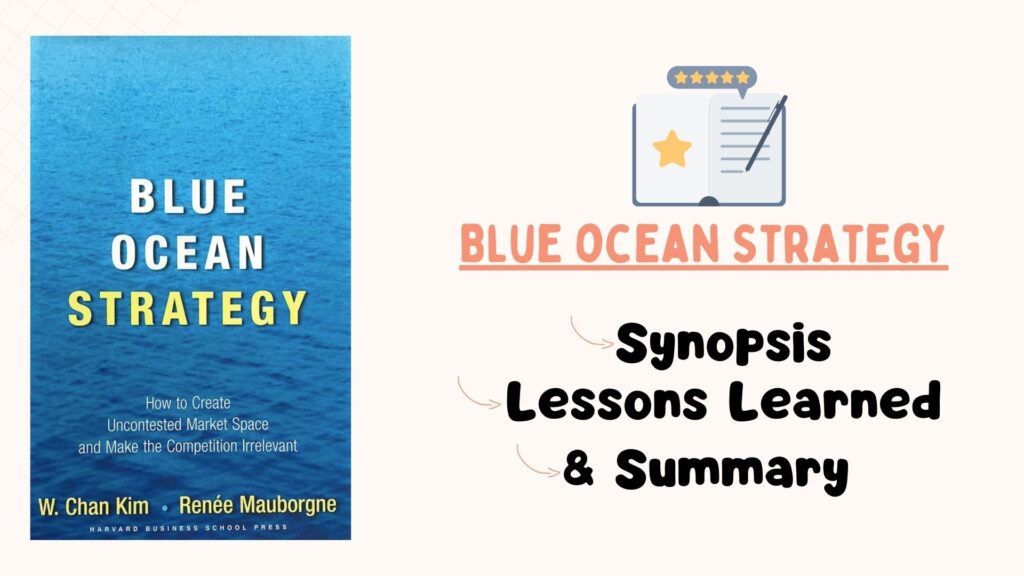Delve into the groundbreaking concepts of Blue Ocean Strategy with our comprehensive explanation and review. Discover the critical frameworks and tools presented in this seminal business book that have the power to revolutionize the way organizations approach competition and innovation. Gain valuable insights into how successful companies have applied the principles of Blue Ocean Strategy to create uncontested market space and achieve sustained growth. Uncover the potential risks and rewards of implementing this strategic approach, and equip yourself with the knowledge needed to thrive in a competitive business landscape.
Key Takeaways:
- Blue Ocean Strategy: The book emphasizes the importance of creating new market spaces, or “blue oceans,” rather than competing in existing markets, or “red oceans.”
- Value Innovation: The authors introduce the concept of value innovation, which involves creating a leap in value for both buyers and the company, while simultaneously reducing costs.
- Focus on Non-Customers: Blue Ocean Strategy encourages businesses to focus on non-customers and understand their needs, in order to uncover new opportunities for market growth.
- Strategy Canvas: The book highlights the use of a strategy canvas to visually compare a company’s strategy against competitors, helping to identify areas for differentiation and new market opportunities.
- Eliminate-Reduce-Raise-Create (ERRC) Grid: The authors introduce the ERRC grid as a tool for companies to systematically analyze their strategy and make decisions about eliminating, reducing, raising, and creating factors in their industry.
- Successful Case Studies: Blue Ocean Strategy provides numerous real-life examples of companies that have successfully applied the principles of creating blue oceans, such as Cirque du Soleil and Southwest Airlines.
- Continuous Innovation: The book emphasizes the importance of continuous innovation and the need for companies to constantly search for new blue ocean opportunities to stay ahead of competition.
Blue Ocean Strategy Unveiled
If you’re looking to gain a competitive edge in the business world, the Blue Ocean Strategy is a game-changer. This innovative approach challenges traditional business thinking and offers a fresh perspective on creating uncontested market space. In this chapter, we will dive deeper into the concept of Blue Ocean Strategy and explore its core principles and framework.
Defining the Blue Ocean Strategy
Blue Ocean Strategy revolves around the idea of creating new market space or “blue oceans” that are untapped and uncontested. In contrast to the traditional “red oceans” where competition is fierce, blue oceans represent opportunities for businesses to thrive in a space of their own making. This strategy encourages organizations to innovate and differentiate rather than compete in existing market spaces, ultimately leading to profitable growth and sustained success.
By focusing on creating value for customers through innovation and strategic positioning, companies can break away from the limitations of competition and chart new territories. The Blue Ocean Strategy emphasizes the importance of understanding customer needs and redefining industry boundaries to create a unique space where competition becomes irrelevant.
Core Principles and Framework
Defining the core principles of the Blue Ocean Strategy involves identification of market factors and strategic planning to shift from competing to creating new market space. This framework includes tools such as the “strategy canvas” which aids in visualizing current market factors and identifying areas for differentiation and innovation. By focusing on value innovation and strategic pricing, companies can effectively reconstruct market boundaries and establish a unique market position.
This approach challenges traditional industry norms and focuses on creating new demand rather than competing for existing demand. Value innovation and strategic agility are at the core of the Blue Ocean Strategy, enabling businesses to unlock new opportunities and drive sustainable growth in untapped market spaces.
Types of Blue Ocean Strategies
Some companies may engage in different types of Blue Ocean Strategies to create uncontested market spaces and drive business success. These strategies can be categorized into various approaches, each with its unique characteristics and benefits.
| Approach | Description |
| Creating Uncontested Market Spaces | Developing new market spaces with limited competition |
| Value Innovation Concepts | Integrating differentiation and low cost to create new value |
| Blue Ocean Leadership | Empowering employees for innovative and market-driving strategies |
| Blue Ocean Process | Systematic approach to create and capture blue oceans |
| Blue Ocean Tools | Frameworks and methodologies for strategy implementation |
Creating Uncontested Market Spaces
Market spaces are created when companies identify and target new groups of customers that are not being served by existing market offerings. This involves redefining industry boundaries and discovering new demand. By doing so, companies can unlock new opportunities for growth and profitability while avoiding direct competition.
Value Innovation Concepts
The key to value innovation is breaking the value-cost trade-off and offering customers a leap in value at a lower cost. This approach helps in creating unrivaled value for buyers and focuses on differentiation and low cost simultaneously. This has a transformative impact on the company’s positioning in the market.
Ocean Strategy emphasizes the importance of value innovation for businesses to stand out in the market and carve a unique position for themselves, away from intense competition. By focusing on creating new value for customers while controlling costs, companies can drive profitable growth and redefine industry standards.
Implementing Blue Ocean Strategy: A Step-by-Step Guide
After understanding the concepts and principles of Blue Ocean Strategy, the next step is to implement it effectively. This involves a systematic approach to identifying your blue ocean, using the strategy canvas and the four actions framework, reconstructing market boundaries, and finally launching and establishing a blue ocean.
| Step 1: Identifying your Blue Ocean | Understanding the factors that make your industry competitive and identifying opportunities for differentiation. |
| Step 2: Strategy Canvas and the Four Actions Framework | Using the strategy canvas to visually compare your offerings with competitors and applying the four actions framework to eliminate, reduce, raise, and create new factors. |
| Step 3: Reconstructing Market Boundaries | Identifying new market segments and creating demand by reaching non-customers. |
| Step 4: Launching and Establishing a Blue Ocean | Implementing the necessary changes, communicating the value proposition, and establishing a long-term strategy for growth and sustainability. |
Identifying your Blue Ocean
Any business looking to implement Blue Ocean Strategy must start by identifying their unique blue ocean. This involves assessing the existing market space and understanding the factors that make the industry competitive. By identifying opportunities for differentiation and innovation, businesses can set the foundation for creating a blue ocean of uncontested market space.
Strategy Canvas and the Four Actions Framework
On the path to implementing Blue Ocean Strategy, the strategy canvas and the four actions framework play a crucial role. By visually mapping factors of competition on the strategy canvas, businesses can gain a clear picture of their industry landscape and identify areas for differentiation. The four actions framework then guides the process of eliminating, reducing, raising, and creating new factors to unlock new value.
Strategy Canvas and the Four Actions Framework: The strategy canvas is a visual tool that allows businesses to compare their offerings with competitors, while the four actions framework provides a systematic approach to making strategic choices that set them apart from the competition.
Reconstructing Market Boundaries
Ocean After identifying the blue ocean and applying the four actions framework, the next step is reconstructing market boundaries. This involves identifying new market segments and creating demand by reaching non-customers. By redefining the market boundaries, businesses can unlock new opportunities for growth and increase market share.
your Reconstructing Market Boundaries: It involves identifying new market segments and creating demand by reaching non-customers. This process enables businesses to tap into unexplored market spaces and unlock new growth opportunities.
Launching and Establishing a Blue Ocean
Ocean After going through the steps of identifying the blue ocean and reconstructing market boundaries, the final step is launching and establishing a blue ocean. With a clear value proposition and strategic plan in place, businesses can communicate their unique offerings to the market and establish a long-term strategy for growth and sustainability.
With Launching and Establishing a Blue Ocean: This involves implementing the necessary changes, communicating the value proposition, and establishing a long-term strategy for growth and sustainability. By effectively launching and establishing a blue ocean, businesses can position themselves for long-term success in uncontested market space.
Factors for Successful Implementation
Unlike developing a business strategy, successful implementation requires a thorough understanding of the organizational culture and a strategic approach to overcoming potential hurdles. It involves the seamless alignment of various components within the organization to ensure a smooth transition towards creating a Blue Ocean.
- Organizational Alignment
- Leadership Commitment
- Employee Involvement
- Resource Allocation
- Performance Measurement
Any successful implementation hinges on the comprehensive integration of these key factors within the organizational framework.
Organizational Alignment and Leadership
Successful implementation of the Blue Ocean Strategy necessitates the alignment of every facet of the organization towards the new strategic direction. It requires leadership commitment to communicate the vision and drive the necessary changes across the organization. Without this alignment, the implementation of a Blue Ocean Strategy can be disrupted by internal resistance, hindering the impactful results that are expected.
Overcoming Key Organizational Hurdles
Overcoming key organizational hurdles is crucial for the successful execution of a Blue Ocean Strategy. The involvement of employees at all levels is vital to mitigate resistance and ensure effective adoption of the new strategy. Additionally, adequate resource allocation and a performance measurement system are essential to monitor the progress and make necessary adjustments along the way.
Pros and Cons of Adopting a Blue Ocean Strategy
Despite the popularity and success of the Blue Ocean Strategy, it is important to carefully consider the advantages and potential drawbacks of adopting this approach. Below, we break down the pros and cons of implementing a Blue Ocean Strategy.
| Pros | Cons |
| Opportunity for creating uncontested market space | Risk of failure if market demand is misunderstood |
| Potential for high profitability and growth | Challenges in breaking from traditional industry boundaries |
| Ability to capture new customer segments | Difficulty in convincing stakeholders to embrace a new approach |
| Emphasis on innovation and value creation | Uncertainty in predicting long-term market acceptance |
| Reduced competition and commoditization | Resource-intensive nature of strategy execution |
Advantages of Pioneering a Blue Ocean
Blue Ocean Strategy offers businesses the opportunity to pioneer new market spaces, free from direct competition. By creating demand where none existed before, companies can reap the rewards of being the first mover and establish a strong market presence without the constraints of traditional industry boundaries. This can lead to enhanced brand recognition and customer loyalty, ultimately resulting in sustainable competitive advantage.
Potential Challenges and Solutions
Prospective challengess of adopting a Blue Ocean Strategy may include uncertainty surrounding market acceptance, stakeholder resistance, and the resource-intensive nature of execution. However, businesses can mitigate these challenges by carefully conducting market research, engaging stakeholders through effective communication, and strategically allocating resources to support the new strategic direction.
Ocean strategy requires a willingness to take calculated risks and a long-term commitment to continuous innovation and value creation. By addressing these challenges head-on, companies stand to gain significant rewards in terms of growth, profitability, and market leadership.
Tips for Maintaining Your Blue Ocean
Now that you have successfully created your Blue Ocean strategy and set your business apart from the competition, it is crucial to continue to nurture and maintain your unique position in the market. Here are a few key tips for keeping your Blue Ocean strategy strong and relevant:
- Monitoring Market Dynamics: Keep a close eye on the market conditions and changes, and adjust your strategy accordingly.
- Continuous Innovation and Adaptation: Stay ahead of the curve by constantly innovating and adapting to the evolving market trends.
- Maintaining a Customer-Centric Approach: Keep your focus on understanding and meeting the needs of your target audience.
- Building and Sustaining Brand Loyalty: Invest in initiatives to foster long-term relationships and loyalty with your customers.
After implementing these tips, you can ensure the longevity and success of your Blue Ocean strategy.
Monitoring Market Dynamics
Oceanic market dynamics play a crucial role in the sustainability of your Blue Ocean strategy. It is imperative to continuously monitor the market conditions, including competitive moves, shifting consumer preferences, and emerging trends. By staying attuned to these changes, you can proactively adjust your strategy to maintain your competitive edge and sustain your unique market space.
Continuous Innovation and Adaptation
Adaptation is key to staying ahead in a rapidly evolving market. Continuous innovation and adaptation are vital components of maintaining a strong Blue Ocean strategy. Embracing change and being open to new ideas and approaches will enable your business to stay relevant and continue offering unique value to your customers.
Market evolution is inevitable, and the ability to adapt and innovate is critical to retaining your competitive advantage. By proactively embracing change and continuously refining your offerings, you can stay ahead of the curve and solidify your position in the Blue Ocean market.
Summing up
Conclusively, “Blue Ocean Strategy” provides a comprehensive framework for businesses to break away from fierce competition and create uncontested market spaces. By focusing on innovation and value creation, rather than competing in crowded marketplaces, companies can pursue new opportunities and unlock new growth. This book offers valuable insights and practical tools for business leaders looking to chart a new path for their organizations. It emphasizes the importance of strategic thinking and encourages a shift in mindset towards creating and capturing new demand, ultimately leading to sustained success in the market.
FAQ
Q: What is Blue Ocean Strategy?
A: Blue Ocean Strategy is a business book that proposes a unique approach to strategy formulation, focusing on creating new market space and making competition irrelevant.
Q: Who are the authors of Blue Ocean Strategy?
A: Blue Ocean Strategy is authored by W. Chan Kim and Renée Mauborgne, who are renowned professors and experts in strategy, innovation, and organizational effectiveness.
Q: What are the key concepts discussed in Blue Ocean Strategy?
A: The key concepts in Blue Ocean Strategy include value innovation, the strategy canvas, the four actions framework, and the six paths framework, which collectively aim to shift the focus from competition to creating uncontested market space.
Q: How does Blue Ocean Strategy differ from traditional business strategies?
A: Blue Ocean Strategy diverges from traditional business strategies by emphasizing innovation and value creation, encouraging businesses to seek out new opportunities and create demand, rather than competing in existing market spaces.
Q: What are some real-world examples of companies that successfully applied Blue Ocean Strategy?
A: Companies such as Cirque du Soleil, Nintendo Wii, and Yellow Tail wine are often cited as successful examples of organizations that have effectively implemented Blue Ocean Strategy principles, leading to significant business growth and market expansion.











